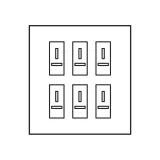SICK Switches and sockets









sick switches and sockets for commercial and residential fit-outs
SICK focuses on wiring devices that install fast, survive daily use, and look clean once plates are on the wall. Modules share a common frame geometry so multi-gang layouts stay aligned even on uneven plaster. Installers get deep terminal wells, captive screws, and clear L/N/PE legends; designers can mix mechanisms and outlets in the same footprint without chasing special boxes.
sick modular wiring devices ranges and formats
The platform covers 1–4 gang plates in thermoset, ABS, and metal finishes; Euro and UK box standards are supported with spacer rings for shallow recesses. Mechanisms include 1-pole, 2-way, intermediate, momentary, key and selector, scene buttons, fan and blind controllers, and rotary/push dimmers. Communication and low-voltage modules—RJ45, coax, keystone blanks—drop into the same grid so refurbishment jobs don’t need a second faceplate family. USB-A/C chargers and pilot indicators fit the same aperture to keep schedules simple.
sick electrical switches mechanisms and ratings
Contacts use AgNi/AgSnO₂ tips with positive-opening NC where safety interlocks are needed. Typical electrical ratings: 250 V AC at 10 A or 16 A, AC-21/AC-22 guidance on load types, and motor/LED load notes per mechanism. Actuation forces sit in the 2–5 N band for gloved operation; mechanical endurance runs 50k–100k cycles. Glow-wire resistance 650–850 °C on visible plastics is standard. Electronic dimmers come in leading-edge (TRIAC) and trailing-edge (MOSFET), plus 1–10 V and DALI-2 interfaces where projects standardize control gear; specify minimum level during commissioning to avoid low-end shimmer on LED drivers.
sick wall sockets grids and shutters
Socket formats include Type F (Schuko) with child-resistant shutters, Type E/F hybrid where required, and Euro 2P for low-power appliances. Typical ratings are 16 A, 250 V AC, with screw or clamp terminals accepting 1.5…2.5 mm² copper. Options: IP44 splash-resistant plates for corridors and utility rooms, illuminated finders for hotel headboards, and angled outlets in tight furniture. Faceplates use UV-stable pigments; contact assemblies are nickel-plated for corrosion control in coastal or humid rooms.
Technical specifications and standards
Devices align with EN/IEC 60669-1 (switches), 60669-2-1 (electronic controls), and IEC 60884-1 (socket-outlets). EMC for electronic modules follows the EN 61000 series; materials meet RoHS. Clearances/creepage are sized for 250 V mains; impulse withstand commonly 2.5–4 kV. Ingress protection: IP20 indoors by default, IP44 with gasketed frames, and higher on designated outdoor boxes. Operating window typically −5…+40 °C; storage to −25…+70 °C. Plate finishes include micro-texture options to resist cleaning swirl marks in hospitality and healthcare.
Applications and compatibility
Apartments and hotels standardize on 2-way plus intermediate for corridors, with locator LEDs in public areas. Offices mix standard circuits with scene buttons to gateways; classrooms benefit from large-cap rockers that students actually hit. Retail back-of-house prefers vandal-resistant plates and screw-covered frames. When a schedule calls up sick power outlets alongside data points, keep a single bezel style so furniture and wall runs read as one system.
Integration with other brand products
Conduit, trunking, and junctions from the same ecosystem keep terminations consistent: divider strips separate SELV from mains, compression glands match cable OD to preserve IP, and label frames align with panel legends. For lighting loops, dimmer modules pair cleanly with LED drivers specified elsewhere on the project. Multi-room programs can pre-bag frames, mechanisms, and screws per room tag; through-box terminals simplify daisies behind continuous desk runs.
Selection criteria for B2B clients
Start with circuit logic (1-way, 2-way, intermediate), then pick mechanism and load type. Confirm box depth versus conductor count; loop-in at the switch wants ≥12 mm free depth behind terminals. Reserve 20–30 % current margin on motor or capacitive loads. Lock plate material against housekeeping chemicals, and choose color/finish early to avoid late-phase rework. Where scene control or BMS tie-in is planned, specify modules compatible with 1–10 V or DALI-2 and publish the minimum stable dim set-point in the handover notes. For mixed hospitality and residential floors, treat the package as sick switch socket systems so spares and finishes remain unified across phases. Small parts—spacer rings, gaskets, locator LEDs—belong on the room kit; list them under sick installation accessories to prevent site hunts.
Advantages of working with Bankoflamps
We align mechanism counts to your room schedules and confirm live EU stock before installers are booked. Quotations land in about an hour with EAN/MPN so finishes, ratings, and control inserts don’t drift mid-phase. Your portal shows lead times, shipment status, and downloadable price lists; pricing validity is held to project gates so approvals don’t expire mid-tender. Approved clients can use post-payment up to 30 days. We consolidate partials by room or floor to cut freight and on-site sorting, and your account manager cross-checks circuit logic, box depth, frame size, ingress class, dimmer load window, and labeling scheme against your drawings—so cartons arrive site-ready and crews spend their time installing, not re-picking.